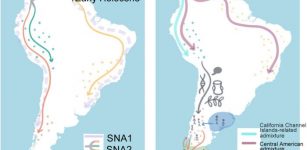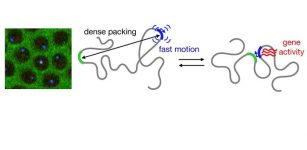Ancient DNA From The Green Sahara Reveals North African Lineage – Study
Eddie Gonzales Jr. – MessageToEagle.com – A new study reveals a long-isolated North African human lineage in the Central Sahara over 7, 000 years ago during the African Humid Period. The study focuses on two 7, 000-year-old Libyan mummies.
7,000-year-old natural mummy found at the Takarkori rock shelter (Individual H1) in Southern Libya. © Archaeological Mission in the Sahara, Sapienza University of Rome
Their genomes lack sub-Saharan ancestry, suggesting the Green Sahara wasn’t a migration corridor but spread herding through cultural exchange. These individuals had less Neandertal DNA, showing they were part of an isolated population.
View from the Takarkori rock shelter in Southern Libya. © Archaeological Mission in the Sahara, Sapienza University of Rome
Limited gene flow: The genomes do not carry sub-Saharan African ancestry, suggesting that, contrary to previous interpretations, the Green Sahara was not a migration corridor between Northern and Sub-Saharan Africa. The spread of migratory herding in the Green Sahara probably occurred through cultural exchange.
Neandertal genetic traces: The ancient individuals had significantly less Neandertal DNA compared to people outside Africa, indicating a largely isolated North African population.
The study provides critical new insights into the African Humid Period, a time between 14,500 and 5,000 years ago when the Sahara desert was a green savanna, rich in water bodies that facilitated human habitation and the spread of pastoralism.
View of the Takarkori rock shelter in Southern Libya. © Archaeological Mission in the Sahara, Sapienza University of Rome
Later aridification turned this region into the world’s largest desert. Due to the extreme aridity of the region today, DNA preservation is poor, making this pioneering ancient DNA study all the more significant.
Genomic analyses reveal that the ancestry of the Takarkori rock shelter individuals primarily derives from a North African lineage that diverged from sub-Saharan African populations at about the same time as the modern human lineages that spread outside of Africa around 50,000 years ago.
The newly described lineage remained isolated, revealing deep genetic continuity in North Africa during the late Ice Age. While this lineage no longer exists in unadmixed form, this ancestry is still a central genetic component of present-day North African people, highlighting their unique heritage.
North Africa remained genetically isolated
Furthermore, these individuals share close genetic ties with 15,000-year-old foragers that lived during the Ice Age in Taforalt Cave, Morocco, associated with the Iberomaurusian lithic industry that predates the African Humid Period. Notably, both groups are equally distant from sub-Saharan African lineages, indicating that despite the Sahara’s greening, gene flow between sub-Saharan and North African populations remained limited during the African Humid Period, contrary to previous suggestions.
The study also sheds light on Neandertal ancestry, showing that the Takarkori individuals have ten-fold less Neandertal DNA than people outside Africa, but more than contemporary sub-Saharan Africans.
“Our findings suggest that while early North African populations were largely isolated, they received traces of Neandertal DNA due to gene flow from outside Africa,” said senior author Johannes Krause, director at the Max Planck Institute for Evolutionary Anthropology.
The spread of pastoralism in the Green Sahara
“Our research challenges previous assumptions about North African population history and highlights the existence of a deeply rooted and long-isolated genetic lineage,” said first author Nada Salem from the Max Planck Institute for Evolutionary Anthropology. “This discovery reveals how pastoralism spread across the Green Sahara, likely through cultural exchange rather than large-scale migration.”
“The study highlights the importance of ancient DNA for reconstructing human history in regions like Central Northern Africa, providing independent support to archaeological hypotheses,” said senior author David Caramelli from the University of Florence.
“By shedding light on the Sahara’s deep past, we aim to increase our knowledge of human migrations, adaptations, and cultural evolution in this key region,” added senior author Savino di Lernia from Sapienza University in Rome.
Paper – Nature, 02 April 2025, DOI: 10.1038/s41586-025-08793-7
Written by Eddie Gonzales Jr. – MessageToEagle.com Staff Writer
Related Posts
-
 What Rosalind Franklin Truly Contributed To Discovery Of DNA’s Structure
No Comments | Apr 26, 2023
What Rosalind Franklin Truly Contributed To Discovery Of DNA’s Structure
No Comments | Apr 26, 2023 -
 “Deleted” Pieces Of DNA May Be What Made Us Human – Scientists Say
No Comments | Apr 29, 2023
“Deleted” Pieces Of DNA May Be What Made Us Human – Scientists Say
No Comments | Apr 29, 2023 -
 Unknown Aspect Of Human Evolution Discovered Through Ancient DNA Study
No Comments | Nov 7, 2022
Unknown Aspect Of Human Evolution Discovered Through Ancient DNA Study
No Comments | Nov 7, 2022 -
 Do We Need ‘Junk DNA’? This Phenomenon Continues To Exist
No Comments | Apr 20, 2023
Do We Need ‘Junk DNA’? This Phenomenon Continues To Exist
No Comments | Apr 20, 2023 -
 The Very First Steps Of DNA Replication – Observed
No Comments | Mar 20, 2025
The Very First Steps Of DNA Replication – Observed
No Comments | Mar 20, 2025 -
 Evolution Mystery – Mini-Proteins In Human Organs Appeared ‘From Nowhere’
No Comments | Feb 20, 2023
Evolution Mystery – Mini-Proteins In Human Organs Appeared ‘From Nowhere’
No Comments | Feb 20, 2023 -
 Cracking The Code Of Pistachio Genetics – New Map
No Comments | Mar 20, 2025
Cracking The Code Of Pistachio Genetics – New Map
No Comments | Mar 20, 2025 -
 New Chemical Reactions To Generate Building Blocks Of Proteins And DNA – Discovered
No Comments | Jul 29, 2022
New Chemical Reactions To Generate Building Blocks Of Proteins And DNA – Discovered
No Comments | Jul 29, 2022 -
 Tracing Chile’s Indigenous Roots Through Genetics And Linguistics
No Comments | Jun 6, 2023
Tracing Chile’s Indigenous Roots Through Genetics And Linguistics
No Comments | Jun 6, 2023 -
 How The Motion Of DNA Controls Gene Activity – DNA Organization In Real-Time:
No Comments | Jul 2, 2023
How The Motion Of DNA Controls Gene Activity – DNA Organization In Real-Time:
No Comments | Jul 2, 2023



